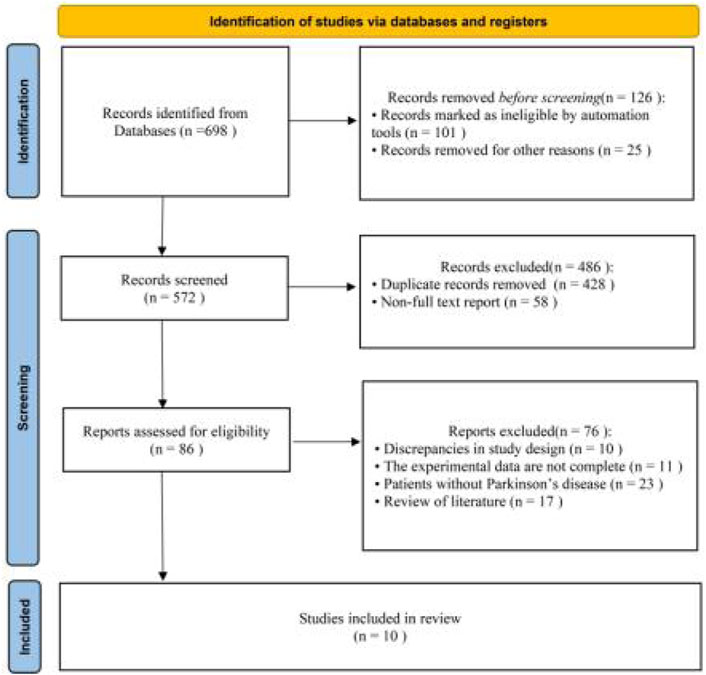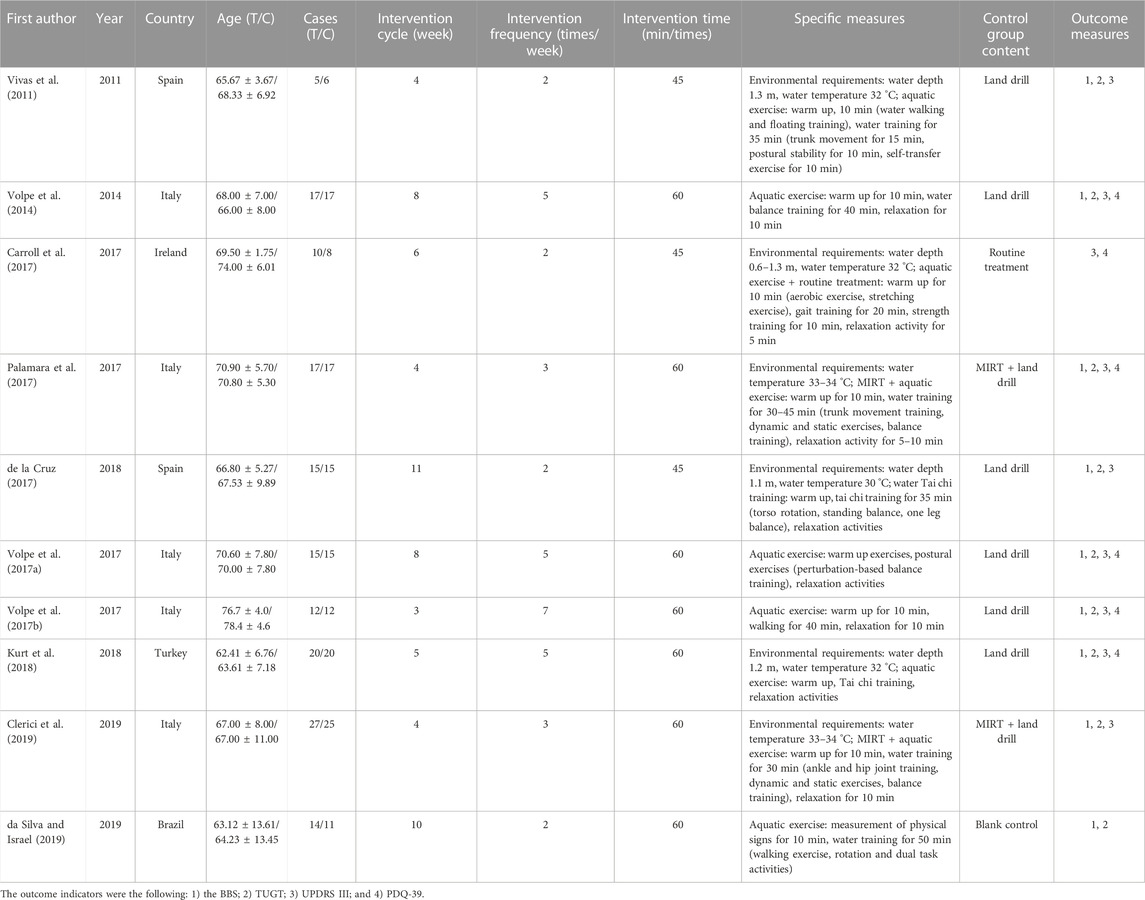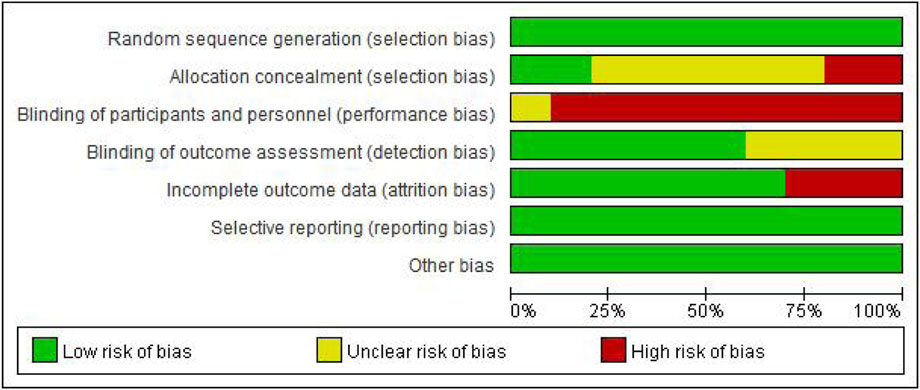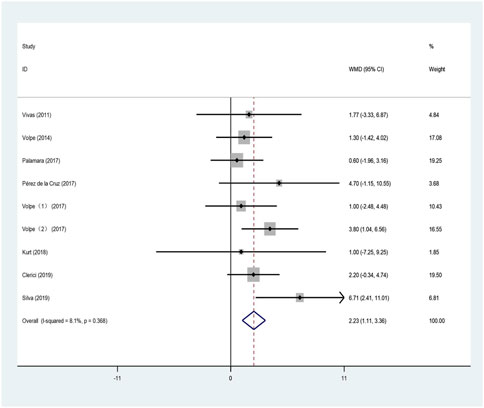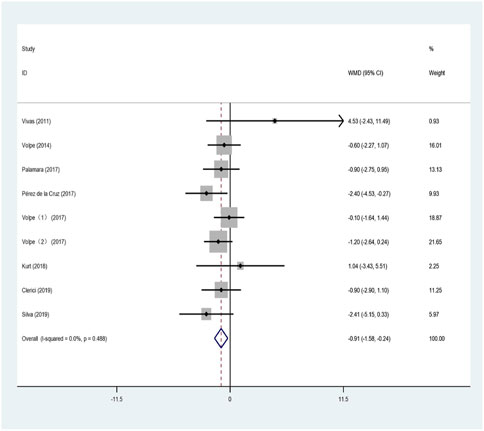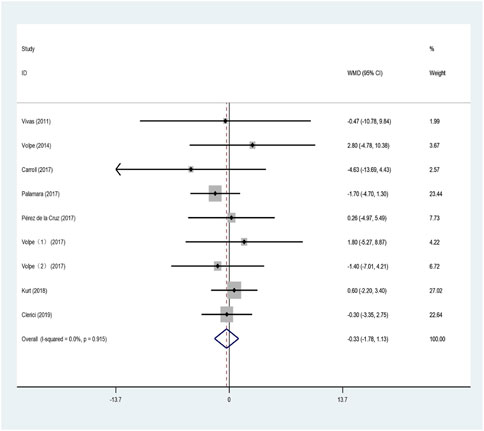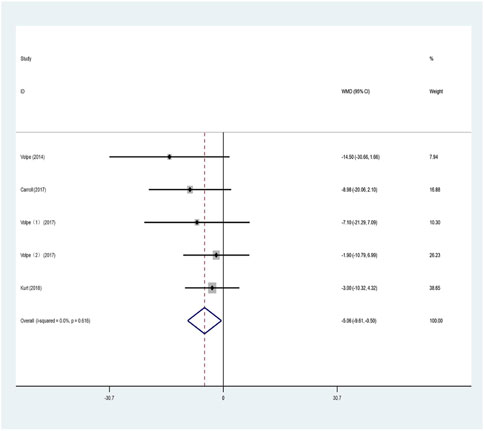- 1Capital University of Physical Education and Sports, Beijing, China
- 2Shenzhen University, Shenzhen, Guangdong, China
Objective: To systematically evaluate the effect of aquatic exercise interventions on the improvement of lower-extremity motor function and quality of life in patients with Parkinson’s disease.
Methods: Two researchers independently searched the literature using the PubMed, Web of Science, Embase, and Cochrane Library databases. The search period was from the establishment of the database to December 2021. The subject heading search included “hydrotherapy,” “hydro therapies,” “hydro therapeutics,” “water therapy,” “aquatic exercise therapy,” “aquatic therapy,” “water-based exercise,” “Parkinson,” “Parkinson disease,” “Parkinson’s disease,” “Parkinson’s syndrome,” “primary Parkinsonism,” “paralysis agitans,” and “randomized controlled trial (RCT).”
Result: A total of 698 articles were retrieved from the four databases by searching for subject headings, and 10 RCT articles were finally included. The balance ability of aquatic exercise in patients with Parkinson’s disease (weighted mean differences [WMD] = 2.234, 95% CI: 1.112–3.357, Z = 3.9, p < 0.01), walking ability (WMD = −0.911, 95% CI: −1.581 to −0.241, Z = 2.67, p < 0.01), and quality of life (WMD = −5.057, 95% CI: −9.610 to −0.504, Z = 2.18, p = 0.029) were improved, but there was no significant difference in motor function (WMD = −0.328, 95% CI: −1.781 to 1.125, Z = 0.44, p = 0.658).
Conclusion: Compared with conventional rehabilitation therapy, aquatic exercise can effectively improve balance, walking ability, and quality of life in patients with Parkinson’s disease. However, it had no obvious effect on improving motor function. This study was limited by the number and quality of the included studies, and more high-quality studies are needed to verify this.
Systematic Review Registration: https://www.crd.york.ac.uk/prospero/, identifier CRD42022365103.
1 Introduction
Parkinson’s disease (PD) was first described as a clinical syndrome by James Parkinson in 1817 (Jankovic and Tan, 2020), and is a disorder characterized by involuntary behavior. Currently, PD is the second most common neurodegenerative disease in the world, with an increasing incidence annually. PD is mainly characterized by resting tremors, bradykinesia, stiffness, postural instability, and various other non-motor symptoms.
The prevalence of PD is increasing faster than that of other neurological diseases (Mele et al., 2020). The global prevalence of PD is 0.3%, accounting for 1%–2% of people over 65 years of age (Wirdefeldt et al., 2011). According to research statistics, the prevalence of PD worldwide is expected to double to more than 14 million people by 2040 (Dorsey and Bloem, 2018). PD, a degenerative disease of the central nervous system with a low mortality and high disability rate, brings great inconvenience to patients’ lives, seriously threatens the physical and mental health of the elderly population, and places a burden on society. This has become a public health problem that needs to be solved urgently (Rana et al., 2022).
Currently, medication remains the main treatment for patients with PD. Many studies have confirmed that exercise therapy is also considered to be one of the effective rehabilitation methods to treat patients with PD. The rehabilitation effect of exercise therapy on the motor function of patients with PD has been proven to improve balance (King et al., 2015) and reduce falls (Shen et al., 2016; Mak et al., 2017). Extensive research has shown that exercise interventions can significantly improve the symptoms of motor disorders and the quality of life of patients with PD through potential mechanisms such as neuroprotective and neuroplastic effects.
Aquatic exercise is widely used in the rehabilitation of neurological diseases (Castro-Sánchez et al., 2012; Marinho-Buzelli et al., 2019; Saleh et al., 2019), and refers to a method of exercise or rehabilitation training and treatment in water, which can relieve the symptoms of patients and improve motor function (Higgins et al., 2011). Aquatic exercise to improve the challenges of PD has been a hot topic of interest for researchers in recent years, but the effects of aquatic exercise on PD patients are still controversial.
Previous studies have shown that aquatic therapy (Giladi, 2009; Ayán Pérez and Cancela, 2014), can improve motor activity, gait, quality of life (Carroll et al., 2017; de la Cruz, 2017; Palamara et al., 2017), and postural stability in patients with mild to moderate PD (Suomi and Koceja, 2000; Devereux et al., 2005; Arnold et al., 2008; Katsura et al., 2010; Elbar et al., 2013). Chae et al. (2020); Li et al. (2017) showed that rehabilitation interventions using the aquatic environment can significantly improve balance function and lower-limb muscle strength in patients, while other studies have also confirmed that aquatic exercise training leads to significant improvements in the health status and activities of daily living in patients with PD (Pellecchia et al., 2004; Perez-Lloret et al., 2014; Volpe et al., 2014). However, Volpe et al. (Volpe et al., 2020) investigated the extent to which underwater gait training improved muscle activity in patients with PD. The study included 10 patients with PD and 10 healthy people, and the walking stride and speed of the PD patients improved on day four after the intervention. Contrastingly, Pinto et al. (Pinto et al., 2019) found that underwater exercise did not significantly improve the quality of life of PD patients compared to traditional land-based exercise training in a systematic review of non-randomized controlled trials. We aimed to conduct a meta-analysis of the literature related to aquatic exercise to improve lower-extremity motor function and quality of life in patients with PD to further explore the application of aquatic interventions in the treatment thereof.
2 Materials and methods
2.1 Literature search
Two researchers independently searched the PubMed, Web of Science, Embase, and Cochrane Library databases. The retrieval period was from the establishment of the database to December, 2021. The search terms included “hydrotherapy,” “hydrotherapies,” “hydrotherapeutics,” “water training,” “aquatic exercise,” “water exercise therapy,” “water therapy,” “aquatic exercise therapy,” “aquatic therapy,” “water-based exercise,” “Parkinson’s disease,” “Parkinson’s syndrome,” “paralysis tremor,” “Parkinson’s syndrome,” “primary Parkinsonism,” “paralysis agitans,” and “randomized controlled trial (RCT).”
2.2 Inclusion and exclusion criteria
The following criteria were required for the included studies: 1) the literature was in Chinese and English full-text; 2) the experimental group involved aquatic exercise; 3) the study was a RCT; 4) the experimental subjects were PD patients (Hoehn–Yahr clinical stage I–IV, PD duration >1 year) without other diseases or complications; 5) the patients were aged >18 years; and 6) the outcomes included the Berg Balance Scale (BBS), timed up-and-go test (TUGT), Parkinson’s Disease Unified Rating Scale III (UPDRS III), and the Parkinson’s disease questionnaire (PDQ)-39.
We excluded studies with the following criteria: 1) the subjects were non-Parkinsonian; 2) the study was a meta-analysis; 3) the experimental design was a non-RCT; 4) the intervention was of non-water exercise; 5) repeatedly published or irrelevant literature; and 6) literature for which original data could not be obtained.
2.3 Literature screening and data extraction
Literature screening and data extraction were independently performed by two investigators according to the inclusion and exclusion criteria. For any disagreements, both parties discussed or consulted a third researcher to assist in adjudication. The following data were extracted: title; first author; publication year; sample size; intervention; intervention time; frequency; and outcome indicators.
2.4 Risk assessment of bias in the included literature
The quality of the included literature was evaluated according to the literature quality assessment standard manual recommended by the Cochrane Manual 5.1.0 (Higgins et al., 2019). The manual evaluates seven types of bias: random sequence generation (selection bias); allocation concealment (selection bias); blinding of participants and personnel (performance bias); blinding of outcome assessment (detection bias); incomplete outcome data (attrition bias); selective reporting (reporting bias); and any other bias. The authors judged the risk of bias of the included literature as low, unclear, or high risk. If there was a dispute, a third party was involved in the discussion until a consensus was reached.
2.5 Statistical analysis
A meta-analysis of the data was performed using the Stata 15 software. Effect sizes were analyzed using weighted mean differences (WMD) or standardized mean differences. An effect size of p ≤ 0.05 indicated statistical significance. The 95% confidence intervals for the fixed- and random-effects models were calculated. When I2 < 50%, the fixed-effects model was used; otherwise, the random-effects model was used for analysis. The articles were analyzed for publication bias using Egger’s test to ensure the reliability of the data.
3 Results
3.1 Literature screening
A total of 698 studies were obtained through a preliminary search. After removing duplicates and excluding studies based on our inclusion and exclusion criteria, 10 RCTs were included in the meta-analysis. The literature screening process is illustrated in Figure 1.
3.2 Basic information of the included literature
Ten articles (Carroll et al., 2017; de la Cruz, 2017; Palamara et al., 2017; Volpe et al., 2014; Vivas et al., 2011; Volpe et al., 2017a; Volpe et al., 2017b; Kurt et al., 2018; Clerici et al., 2019; da Silva and Israel, 2019) were included in this study. A total of 298 patients with PD were included, with 152 in the experimental group and 146 in the control group. Hoehn–Yahr stage (H&Y) was used to evaluate the degree of PD. The outcome indicators were the BBS, TUGT, UPDRS III, and PDQ-39. Basic information on the included studies is presented in Table 1.
3.3 Quality assessment
According to the Cochrane Collaboration risk-of-bias assessment tool standard, the 10 RCTs included were of moderate quality (Figure 2).
3.4 Results of meta-analysis
3.4.1 BBS
The BBS is a comprehensive scale composed of 14 indicators used to evaluate balance and fall risk in the elderly (Berg et al., 1989). The higher the score, the lower the risk of fall. Nine studies used the BBS to evaluate the effect of aquatic exercise on balance function in patients with PD. The results of combining data from the included studies for the meta-analysis are shown in Figure 3.
The heterogeneity test indicated large heterogeneity (I2 = 8.1%, p = 0.368); therefore, the fixed-effects model was used for analysis. This indicates that, compared with land-based training or routine nursing, aquatic exercise had a positive effect on balance function in patients (WMD = 2.234; 95% CI: 1.112–3.357; Z = 3.9; p < 0.01).
3.4.2 TUGT
This test is often used to assess balance and physical fitness. The subject sits in a chair with armrests, stands up from the chair, walks forward to a straight line 3 m after hearing a command, turns around, walks back to the chair, turns around, and sits down smoothly. The tester records the time to complete the entire process. The shorter the time, the better the balance and physical ability (Benecke et al., 1987).
Nine studies used TUGT to evaluate the effect of aquatic exercise on the walking ability of patients with PD. The results were analyzed by combining the data from the included studies in a meta-analysis, as shown in Figure 4. The heterogeneity test indicated small heterogeneity (I2 = 0%, p = 0.488); therefore, the fixed-effects model was used for analysis. This indicated that aquatic exercise can significantly improve the walking ability of patients with PD compared with land-based training or routine nursing (WMD = −0.911; 95% CI: −1.581 to −0.241; Z = 2.67; p < 0.01).
2.4.3 UPDRS III
The UPDRS III is a commonly used scale to evaluate the quality of life of patients with PD, and is used to evaluate the motor function and signs of patients (Vivas et al., 2011). Ten studies used the UPDRS Ⅲ score to evaluate the effect of aquatic exercise on lower-extremity muscle strength in patients with PD. The meta-analysis was performed by combining data from the included studies, and the results are shown in Figure 5.
The heterogeneity test showed that the heterogeneity was small (I2 = 0%, p = 0.915); therefore, the fixed-effects model was used for the analysis. This indicated that, compared with land-based training or routine nursing groups, aquatic exercise has no significant improvement effect on the motor function of patients with PD (WMD = −0.328; 95% CI: −1.781 to 1.125; Z = 0.44; p < 0.01).
2.4.4 Quality of life
The PDQ-39 is composed of eight items and 39 questions. A lower score indicates better quality of life is (Villegas and Israel, 2014). Five studies used the PDQ-39 to evaluate the effects of aquatic exercise on the quality of life of patients with Parkinson’s.
The results were analyzed by combining the data from the included studies in a meta-analysis, as shown in Figure 6. The heterogeneity test revealed no heterogeneity (I2 = 0%, p = 0.616); therefore, the fixed-effects model was used for the analysis. This indicated that, compared with land-based training or routine nursing groups, aquatic exercise has a significant improvement effect on the quality of life of patients with PD (WMD = −5.057; 95% CI: −9.610 to −0.504; Z = 2.18; p = 0.029).
4 Discussion
A total of 698 articles were retrieved from the four databases by searching for the subject headings, and 10 RCT articles were finally included. The balance ability of aquatic exercise in patients with PD, walking ability, and quality of life improved, but there was no significant difference in motor function.
In recent years, the incidence of PD and its related complications has increased worldwide. PD not only involves motor and behavioral disorders but also has certain effects on cognitive function and mood. The main characteristics of motor behavioral disorders are reduced movement, stiffness, tremors, postural instability, and abnormal gait. Numerous studies have confirmed that exercise training can improve symptoms, delay the progression of PD, and promote motor function rehabilitation (Allen et al., 2011; Combs et al., 2011; Duncan and Earhart, 2012; Tseng et al., 2015; Zhang et al., 2015).
In the process of exploring exercise interventions to improve the symptoms of PD, aquatic exercise has been regarded as an important treatment strategy and has demonstrated some unique advantages. Aquatic exercise therapy is a treatment that makes use of the buoyancy, resistance, hydrostatic pressure, and fluidity of water to allow PD patients to perform exercise to train muscle strength, control, and coordination to relieve their symptoms or improve motor function (Towler et al., 1987; Pinto et al., 2019). We adopted the measurement of Parkinson’s patients with lower-extremity motor function and quality of life indexes; the commonly used evaluations after the relevant indicators, according to the results of the aquatic exercise, can effectively improve balance and walking ability, and improve patient quality of life. However, the control group showed no significant improvement in sports ability. Pinto (Pinto et al., 2019) and Cugusi (Cugusi et al., 2019) conducted systematic evaluations and meta-analyses that were also consistent with the results of this study, which verified the effectiveness of aquatic exercise therapy in the improvement of PD symptoms.
The consequences of impaired balance function in patients with PD are manifested in defects in control support ability during daily activities (Johnell et al., 1992; Sato et al., 2001), which is an important cause of falls in PD patients, and serious cases may lead to fractures and death (Foreman et al., 2011). Improving the balance of patients can reduce the risk of balance-related falls (Wong-Yu and Mak, 2019). The BBS is often used to assess balance and fall risk in older adults (Berg et al., 1989). In this study, the BBS was used to evaluate the balance function of PD patients. The results indicated that aquatic exercise had a positive effect on balance compared with land-based training or routine nursing (WMD = 2.234; 95% CI: 1.112–3.357; Z = 3.9; p < 0.01).
The European physiotherapy guidelines for exercise in PD recommend that treatment should be maintained for 8 weeks, three times a week for 45 min. According to the studies included here, the length of the aquatic exercise intervention was found to be 45–60 min and the duration of the intervention 3–11 weeks (Domingos et al., 2018). Although some studies did not meet the criteria of the European physiotherapy guidelines for exercise in PD, all included studies showed some improvement in the symptoms of PD patients through the intervention. Zhu et al. (Zhu et al., 2018) compared 46 cases of Hoehn–Yahr stage 2–3 PD patients who were randomly assigned to hydrotherapy or disorder hydrotherapy groups. All subjects received 30 min of aquatic therapy, five times a week for 6 weeks. The results of the study showed that both aquatic therapy regimens improved balance in PD patients, and gait freeze was significantly relieved after this training, which indicates that obstacle aquatic therapy was more effective than traditional aquatic therapy. Therefore, aquatic exercise is a feasible treatment for balance dysfunction in PD patients. The results of the studies by Volpe et al. (2014); Kurt et al. (2018) were similar to ours. Saleh and Masiero’s study also showed that aquatic exercise enhances proprioception and promotes balance in patients with PD (Masiero et al., 2019; Saleh et al., 2019). Therefore, when performing aquatic exercise interventions in PD patients, researchers should use the appropriate period, frequency, and duration of interventions to achieve greater effectiveness and scientific validity of aquatic exercise interventions for PD patients.
TUGT is a walking ability test that involves standing up, walking, turning, and sitting down sequentially (Benecke et al., 1987). Studies use the TUGT to evaluate the walking function of PD patients, and a longer time indicated worse walking function. A meta-analysis of the included literature indicated that aquatic exercise significantly improved walking ability in patients with PD compared with land-based training or routine nursing groups (WMD = −0.911; 95% CI: −1.581 to −0.241; Z = 2.67; p < 0.01). Studies of patients with PD have found that three (Palamara et al., 2017) to five treatments per week (Volpe et al., 2014; Kurt et al., 2018; Zhu et al., 2018) result in greater improvements in functional activity and gait in the aquatic exercise group compared to land-based training. This suggests that, to obtain clinically meaningful improvements in exercise in PD, treatment should be performed at least three times per week. Athletes with PD show reduced stride length and gait speed after injury (Tan et al., 2011), and Carroll proposed that the degree of gait change is related to the length of the intervention time (Carroll et al., 2017). Studies have found that aquatic exercise improves postural control, gait parameters (speed, rhythm, stride length), and hip motion in patients with PD (Volpe et al., 2017b), especially hip rotation and knee and ankle flexion (Cancela et al., 2015).
The buoyancy of water can reduce the load on both lower extremities and the impact of the ground reaction force on the joints, which can effectively improve the stability of the foot and walking ability (Masumoto et al., 2013). Paula found that the displacement angles of the hip, knee, and ankle joints of Parkinson’s patients increased, which increased the stability of posture and reflected the increase in physical resistance in the hydrotherapy environment (Rodriguez et al., 2013). Several studies have shown that aquatic exercise therapy can significantly improve gait variability (walking speed, stride length, and single and double support times) in patients with PD, which is significant for rehabilitation gait training (Ayán et al., 2014; Carroll et al., 2017; Zhu et al., 2018; Clerici et al., 2019).
Extensive studies have shown that exercise interventions can effectively improve movement disorders and promote the rehabilitation of motor function in patients with Parkinson’s (Tseng et al., 2015; Zhang et al., 2015; Ni et al., 2016; Taghizadeh et al., 2018). Aquatic exercise has gradually been applied as a new type of rehabilitation therapy. Vivas tested 11 patients with stage 2 or stage 3 idiopathic PD who were trained for a period of 4 weeks of individual training for 45 min, twice a week. The results showed that the UPDRS III score of the aquatic exercise group significantly increased, and the motor activity of PD patients improved (Vivas et al., 2011). Aquatic exercise improves body control and movement as well as flexibility in patients with PD, being able to constantly adjust their behavior and motor control in the water, keeping the body in a relaxed and physically extended state with slow and continuous movements (Villegas and Israel, 2014; Pérez-de la Cruz, 2019). In this study, the UPDRS III score was used to evaluate the effect of aquatic exercise on lower-limb muscle strength in patients with Parkinson’s. The results of the meta-analysis indicated that, compared with land-based training or routine nursing, aquatic exercise had no obvious improvement effect on the motor activity of patients with PD (WMD = −0.328; 95% CI: −1.781 to 1.125; Z = 0.44; p = 0.658). This differs from the results of a study by Terrens et al. (2018), and may be related to the small number of included studies, age of the subjects, different years of disease, and long-term exercise.
The PDQ-39 scale can be used to evaluate the quality of life of patients with PD, with lower scores indicating better quality of life (Villegas and Israel, 2014). In this study, the PDQ-39 was used to evaluate the effects of aquatic exercise on the quality of life of patients with Parkinson’s. The meta-analysis indicated that, compared with land-based training or routine nursing groups, aquatic exercise had a significant improvement effect on the quality of life of patients (WMD = −5.057, 95% CI: −9.610 to −0.504; p = 0.029), which is the same as the study results of Ayán and Cancela. (2012); Cugusi et al. (2019). Numerous studies have also shown a positive effect of aquatic exercise in improving the quality of life of patients with PD (Ayán and Cancela, 2012; Shahmohammadi et al., 2017), with significant improvements in pain, depression, and quality of life indicators (Pérez-de la Cruz, 2019), which are more conducive to better rehabilitation effects (Shulman et al., 2002; Volpe et al., 2014; Volpe et al., 2017a; Kurt et al., 2018). However, the results of the meta-analysis by Pinto et al. (2019) are contrary to the results of this study, which may be related to the small number of included studies.
Aquatic exercise may improve the quality of life of PD patients due to the following reasons: 1) aquatic exercise is unique in that individuals can be subjected to the pressure of the water, relieving muscle fatigue and reducing pain during exercise (Morris, 2010; Vivas et al., 2011; Volpe et al., 2014); 2) aquatic exercise can improve the balance function of patients, expand the range of activities, and thus improve the ability of daily activities (Pellecchia et al., 2004; Volpe et al., 2017a); 3) regular physical exercise can enhance self-efficacy, reduce anxiety and depression, improve mood and self-esteem, relieve stress, and improve quality of life (Peluso and De Andrade, 2005; Pérez-de la Cruz, 2019).
Furthermore, aquatic exercise can improve the symptoms of Parkinson’s patients by the following possible mechanisms. 1) Water has specific physical properties and the density of water is higher than that of air; patients can undergo resistance from all directions, which can effectively strengthen and exercise the patient postural control ability, improve muscle strength, muscular endurance, and joint mobility, thus improving balance function. The use of water buoyancy can reduce the contraction load of the lower limbs and the impact force on the joints, and reduce the difficulty of movement and the risk of walking training. Previous studies have confirmed that aquatic exercises can more effectively control posture and maintain balance (Becker, 2009; Zhang et al., 2016; Zhu et al., 2018). 2) The warming effect of water can stimulate temperature receptors and activate cortical sensory-related areas, regulate oxidative stress, increase the reaction between nerves and hippocampus (Silva Germanos et al., 2019; Dani et al., 2020), increase the activity of cortical sensory and motor areas, and promote sensorimotor integration. It also increases the extensibility of collagen tissue (Ardıç et al., 2007), inhibits the over-excitability of the stretch reflex, improves the flexibility of muscle function, relieves stiffness, and increases the self-confidence and training enthusiasm of patients.
This study had some limitations. First, the number of included studies was small, with a lack of long-term follow-up and long-term traceability. Second, the intervention programs were not uniform, and the intervention duration, frequency, and temperature of the pool may have affected the results. Third, the included studies did not clearly indicate the implementation of allocation hiding and blinding, which may have an impact on the credibility of the results.
5 Conclusion
Aquatic exercise can effectively improve the balance function, walking ability, and quality of life of patients with PD, but the improvement effect on the motor function of patients is not significant, limited by the number and quality of the included studies. Further studies are required, with the inclusion of high-quality RCTs.
Data availability statement
The original contributions presented in the study are included in the article/supplementary material, further inquiries can be directed to the corresponding authors.
Author contributions
SD, HY, and SW conceptualized and designed the study. SW provided administrative support. SD and HY were responsible for document retrieval. SD, HY, and JW were in charge of the collection and assembly of data. JW, YY, and SW analyzed and interpreted the data. All authors wrote and approved the final version of the manuscript.
Funding
This work was supported by the Humanities and Social Sciences Program of the Ministry of Education of the People’s Republic of China in 2022 under grant 22YJA890028 and Beijing Social Science Foundation Project in 2019 under grant 19YTB011.
Conflict of interest
The authors declare that the research was conducted in the absence of any commercial or financial relationships that could be construed as a potential conflict of interest.
Publisher’s note
All claims expressed in this article are solely those of the authors and do not necessarily represent those of their affiliated organizations, or those of the publisher, the editors and the reviewers. Any product that may be evaluated in this article, or claim that may be made by its manufacturer, is not guaranteed or endorsed by the publisher.
References
Allen N. E., Sherrington C., Paul S. S., Canning C. G. (2011). Balance and falls in Parkinson's disease: A meta-analysis of the effect of exercise and motor training. Mov. Disord. 26 (9), 1605–1615. doi:10.1002/mds.23790
Ardıç F., Özgen M., Aybek H., Rota S., Cubukcu D., Gokgoz A. (2007). Effects of balneotherapy on serum IL-1, PGE2 and LTB4 levels in fibromyalgia patients. Rheumatol. Int. 27 (5), 441–446. doi:10.1007/s00296-006-0237-x
Arnold C. M., Busch A. J., Schachter C. L., Harrison E. L., Olszynski W. P. (2008). A randomized clinical trial of aquatic versus land exercise to improve balance, function, and quality of life in older women with osteoporosis. Physiother. Can. 60 (4), 296–306. doi:10.3138/physio.60.4.296
Ayán C., Cancela J. (2012). Feasibility of 2 different water-based exercise training programs in patients with Parkinson's disease: A pilot study. Archives Phys. Med. rehabilitation 93 (10), 1709–1714. doi:10.1016/j.apmr.2012.03.029
Ayán C., Cancela J. M., Gutiérrez-Santiago A., Gutierrez-SantiAgo A. (2014). Effects of two different exercise programs on gait parameters in individuals with Parkinson's disease: A pilot study. Gait posture 39 (1), 648–651. doi:10.1016/j.gaitpost.2013.08.019
Ayán Pérez C., Cancela J. M. (2014). Effectiveness of water-based exercise in people living with Parkinson’s disease: A systematic review. Eur. Rev. Aging Phys. Activity 11 (2), 107–118. doi:10.1007/s11556-013-0135-7
Becker B. E. (2009). Aquatic therapy: Scientific foundations and clinical rehabilitation applications. Pm&r 1 (9), 859–872. doi:10.1016/j.pmrj.2009.05.017
Benecke R., Rothwell J. C., Dick J. P. R., Day B. L., Marsden C. D. (1987). Disturbance of sequential movements in patients with Parkinson's disease. Brain 110 (2), 361–379. doi:10.1093/brain/110.2.361
Berg K., Wood-Dauphine S., Williams J. I., Gayton D. (1989). Measuring balance in the elderly: Preliminary development of an instrument. Physiother. Can. 41 (6), 304–311. doi:10.3138/ptc.41.6.304
Cancela J. M., Ayan C., Nascimento C. M. C., Seijo-Martinez M. (2015). Effects of water-based and callisthenic exercise on freezing of gait, postural control, and functional independence in patients with mild to moderate Parkinson disease. Top. Geriatric Rehabilitation 31 (2), 152–158. doi:10.1097/tgr.0000000000000062
Carroll L. M., Volpe D., Morris M. E., Saunders J., Clifford A. M. (2017). Aquatic exercise therapy for people with Parkinson disease: A randomized controlled trial. Archives Phys. Med. rehabilitation 98 (4), 631–638. doi:10.1016/j.apmr.2016.12.006
Castro-Sánchez A. M., Matarán-Peñarrocha G. A., Lara-Palomo I., Saavedra-Hernandez M., Arroyo-Morales M., Moreno-Lorenzo C. (2012). Hydrotherapy for the treatment of pain in people with multiple sclerosis: A randomized controlled trial. Evidence-based complementary Altern. Med. 2012, 473963. doi:10.1155/2012/473963
Chae C. S., Jun J. H., Im S., Jang Y., Park G. Y. (2020). Effectiveness of hydrotherapy on balance and paretic knee strength in patients with stroke: A systematic review and meta-analysis of randomized controlled trials. Am. J. Phys. Med. rehabilitation 99 (5), 409–419. doi:10.1097/PHM.0000000000001357
Clerici I., Maestri R., Bonetti F., Ortelli P., Volpe D., Ferrazzoli D., et al. (2019). Land plus aquatic therapy versus land-based rehabilitation alone for the treatment of freezing of gait in Parkinson disease: A randomized controlled trial. Phys. Ther. 99 (5), 591–600. doi:10.1093/ptj/pzz003
Combs S. A., Diehl M. D., Staples W. H., Conn L., Davis K., Lewis N., et al. (2011). Boxing training for patients with Parkinson disease: A case series. Phys. Ther. 91 (1), 132–142. doi:10.2522/ptj.20100142
Cugusi L., Manca A., Bergamin M., Di Blasio A., Monticone M., Deriu F., et al. (2019). Aquatic exercise improves motor impairments in people with Parkinson's disease, with similar or greater benefits than land-based exercise: A systematic review. J. Physiother. 65 (2), 65–74. doi:10.1016/j.jphys.2019.02.003
da Silva A. Z., Israel V. L. (2019). Effects of dual-task aquatic exercises on functional mobility, balance and gait of individuals with Parkinson's disease: A randomized clinical trial with a 3-month follow-up. Complementary Ther. Med. 42, 119–124. doi:10.1016/j.ctim.2018.10.023
Dani C., Proença I. T., Marinho J., Peccin P., da Silva I. R. V., Nique S., et al. (2020). Aquatic exercise program-modulated oxidative stress markers in patients with Parkinson's disease. Neural Regen. Res. 15 (11), 2067–2072. doi:10.4103/1673-5374.276337
de la Cruz S. P. (2017). Effectiveness of aquatic therapy for the control of pain and increased functionality in people with Parkinson's disease: A randomized clinical trial. J. 53 (6), 825–832. doi:10.23736/S1973-9087.17.04647-0
Devereux K., Robertson D., Briffa N. K. (2005). Effects of a water-based program on women 65 years and over: A randomised controlled trial. Aust. J. Physiother. 51 (2), 102–108. doi:10.1016/s0004-9514(05)70038-6
Domingos J., Keus S. H. J., Dean J., de Vries N. M., Ferreira J. J., Bloem B. R. (2018). The European physiotherapy guideline for Parkinson's disease: Implications for neurologists. J. Parkinson's Dis. 8 (4), 499–502. doi:10.3233/JPD-181383
Dorsey E. R., Bloem B. R. (2018). The Parkinson pandemic-A call to action. JAMA neurol. 75 (1), 9–10. doi:10.1001/jamaneurol.2017.3299
Duncan R. P., Earhart G. M. (2012). Randomized controlled trial of community-based dancing to modify disease progression in Parkinson disease. Neurorehabilitation neural repair 26 (2), 132–143. doi:10.1177/1545968311421614
Elbar O., Tzedek I., Vered E., Shvarth G., Friger M., Melzer I. (2013). A water-based training program that includes perturbation exercises improves speed of voluntary stepping in older adults: A randomized controlled cross-over trial. Archives gerontology geriatrics 56 (1), 134–140. doi:10.1016/j.archger.2012.08.003
Foreman K. B., Addison O., Kim H. S., Dibble L. E. (2011). Testing balance and fall risk in persons with Parkinson disease, an argument for ecologically valid testing. Park. Relat. Disord. 17 (3), 166–171. doi:10.1016/j.parkreldis.2010.12.007
Giladi N. (2009). Mobility and exercise in movement disorders. Park. Relat. Disord. 15, S46–S48. doi:10.1016/S1353-8020(09)70779-5
Higgins J. P. T., Thomas J., Chandler J., Cumpston M., Li T., Page M., et al. (2019). Cochrane handbook for systematic reviews of interventions[M]. United States: John Wiley & Sons.
Higgins T. R., Heazlewood I. T., Climstein M. (2011). A random control trial of contrast baths and ice baths for recovery during competition in U/20 rugby union. J. Strength & Cond. Res. 25 (4), 1046–1051. doi:10.1519/JSC.0b013e3181cc269f
Jankovic J., Tan E. K. (2020). Parkinson's disease: Etiopathogenesis and treatment. J. Neurology, Neurosurg. Psychiatry 91 (8), 795–808. doi:10.1136/jnnp-2019-322338
Johnell O., Melton L. J., Atkinson E. J., O'Fallon W. M., Kurland L. T. (1992). Fracture risk in patients with parkinsonism: A population-based study in olmsted county, Minnesota. Age ageing 21 (1), 32–38. doi:10.1093/ageing/21.1.32
Katsura Y., Yoshikawa T., Ueda S. Y., Usui T., Sotobayashi D., Nakao H., et al. (2010). Effects of aquatic exercise training using water-resistance equipment in elderly. Eur. J. Appl. physiology 108 (5), 957–964. doi:10.1007/s00421-009-1306-0
King L. A., Wilhelm J., Chen Y., Blehm R., Nutt J., Chen Z., et al. (2015). Effects of group, individual, and home exercise in persons with Parkinson disease: A randomized clinical trial. J. Neurologic Phys. Ther. 39 (4), 204–212. doi:10.1097/NPT.0000000000000101
Kurt E. E., Büyükturan B., Büyükturan Ö., Erdem H. R., Tuncay F. (2018). Effects of Ai Chi on balance, quality of life, functional mobility, and motor impairment in patients with Parkinson's disease<sup/>. Disabil. rehabilitation 40 (7), 791–797. doi:10.1080/09638288.2016.1276972
Li C., Khoo S., Adnan A. (2017). Effects of aquatic exercise on physical function and fitness among people with spinal cord injury: A systematic review. Medicine 96 (11), e6328. doi:10.1097/MD.0000000000006328
Mak M. K., Wong-Yu I. S., Shen X., Chung C. L. (2017). Long-term effects of exercise and physical therapy in people with Parkinson disease. Nat. Rev. Neurol. 13 (11), 689–703. doi:10.1038/nrneurol.2017.128
Marinho-Buzelli A. R., Zaluski A. J., Mansfield A., Bonnyman A. M., Musselman K. E. (2019). The use of aquatic therapy among rehabilitation professionals for individuals with spinal cord injury or disorder. J. spinal cord Med. 42, 158–165. doi:10.1080/10790268.2019.1647935
Masiero S., Maghini I., Mantovani M. E., Bakdounes L., Koutsikos K., Del Felice A., et al. (2019). Is the aquatic thermal environment a suitable place for providing rehabilitative treatment for person with Parkinson’s disease? A retrospective study[J]. Int. J. biometeorology 63 (1), 13–18. doi:10.1007/s00484-018-1632-1
Masumoto K., Applequist B. C., Mercer J. A. (2013). Muscle activity during different styles of deep water running and comparison to treadmill running at matched stride frequency. Gait Posture 37 (4), 558–563. doi:10.1016/j.gaitpost.2012.09.019
Mele B., Van S., Holroyd-Leduc J., Ismail Z., Pringsheim T., Goodarzi Z. (2020). Diagnosis, treatment and management of apathy in Parkinson's disease: A scoping review. BMJ open 10 (9), e037632. doi:10.1136/bmjopen-2020-037632
Morris D. M. (2010). Aquatic therapy to improve balance dysfunction in older adults. Top. Geriatric Rehabilitation 26 (2), 104–119. doi:10.1097/tgr.0b013e3181dfda0a
Ni M., Signorile J. F., Mooney K., Balachandran A., Potiaumpai M., Luca C., et al. (2016). Comparative effect of power training and high-speed yoga on motor function in older patients with Parkinson disease. Archives Phys. Med. rehabilitation 97 (3), 345. doi:10.1016/j.apmr.2015.10.095
Palamara G., Gotti F., Maestri R., Bera R., Gargantini R., Bossio F., et al. (2017). Land plus aquatic therapy versus land-based rehabilitation alone for the treatment of balance dysfunction in Parkinson disease: A randomized controlled study with 6-month follow-up. Archives Phys. Med. rehabilitation 98 (6), 1077–1085. doi:10.1016/j.apmr.2017.01.025
Pellecchia M. T., Grasso A., Biancardi L. G., BonaVita V., Barone P. (2004). Physical therapy in Parkinson's disease: An open long-term rehabilitation trial. J. neurology 251 (5), 595–598. doi:10.1007/s00415-004-0379-2
Peluso M. A. M., De Andrade L. H. S. G. (2005). Physical activity and mental health: The association between exercise and mood. Clinics 60 (1), 61–70. doi:10.1590/s1807-59322005000100012
Pérez-de la Cruz S. (2019). Mental health in Parkinson's disease after receiving aquatic therapy: A clinical trial. Acta Neurol. Belg. 119 (2), 193–200. doi:10.1007/s13760-018-1034-5
Perez-Lloret S., Negre-Pages L., Damier P., Delval A., Derkinderen P., Destee A., et al. (2014). Prevalence, determinants, and effect on quality of life of freezing of gait in Parkinson disease. JAMA neurol. 71 (7), 884–890. doi:10.1001/jamaneurol.2014.753
Pinto C., Salazar A. P., Marchese R. R., Stein C., Pagnussat A. S. (2019). The effects of hydrotherapy on balance, functional mobility, motor status, and quality of life in patients with Parkinson disease: A systematic review and meta-analysis. PM&R 11 (3), 278–291. doi:10.1016/j.pmrj.2018.09.031
Rana A., Dumka A., Singh R., Panda M. K., Priyadarshi N., Twala B. (2022). Imperative role of machine learning algorithm for detection of Parkinson's disease: Review, challenges and recommendations. Diagnostics 12 (8), 2003. doi:10.3390/diagnostics12082003
Rodriguez P., Cancela J. M., Ayan C., do Nascimento C., Seijo-Martinez M. (2013). [Effects of aquatic physical exercise on the kinematic gait pattern in patients with Parkinson's disease: A pilot study]. Rev. Neurol. 56 (6), 315–320. doi:10.33588/rn.5606.2012572
Saleh M. S. M., Rehab N. I., Aly S. M. A. (2019). Effect of aquatic versus land motor dual task training on balance and gait of patients with chronic stroke: A randomized controlled trial. NeuroRehabilitation 44 (4), 485–492. doi:10.3233/NRE-182636
Sato Y., Kaji M., Tsuru T., Oizumi K. (2001). Risk factors for hip fracture among elderly patients with Parkinson's disease. J. neurological Sci. 182 (2), 89–93. doi:10.1016/s0022-510x(00)00458-5
Shahmohammadi R., Sharifi G. R., Melvin J., Sadeghi-Demneh E. (2017). A comparison between aquatic and land-based physical exercise on postural sway and quality of life in people with Parkinson’s disease: A randomized controlled pilot study. Sport Sci. Health 13 (2), 341–348. doi:10.1007/s11332-017-0363-8
Shen X., Wong-Yu I. S. K., Mak M. K. Y. (2016). Effects of exercise on falls, balance, and gait ability in Parkinson's disease: A meta-analysis. Neurorehabilitation neural repair 30 (6), 512–527. doi:10.1177/1545968315613447
Shulman L. M., Taback R. L., Rabinstein A. A., Weiner W. J. (2002). Non-recognition of depression and other non-motor symptoms in Parkinson's disease. Park. Relat. Disord. 8 (3), 193–197. doi:10.1016/s1353-8020(01)00015-3
Silva Germanos S. da, Vieira B., da Silva I. R. V., da Cunha J. J., Nique S., Striebel V., et al. (2019). The impact of an aquatic exercise program on BDNF levels in Parkinson's disease patients: Short-and long-term outcomes. Funct. Neurol. 34 (2), 65–70.
Suomi R., Koceja D. M. (2000). Postural sway characteristics in women with lower extremity arthritis before and after an aquatic exercise intervention. Archives Phys. Med. rehabilitation 81 (6), 780–785. doi:10.1016/s0003-9993(00)90111-4
Taghizadeh G., Azad A., Kashefi S., Fallah S., Daneshjoo F. (2018). The effect of sensory-motor training on hand and upper extremity sensory and motor function in patients with idiopathic Parkinson disease. J. Hand Ther. 31 (4), 486–493. doi:10.1016/j.jht.2017.08.001
Tan D. M., McGinley J. L., Danoudis M. E., Iansek R., Morris M. E. (2011). Freezing of gait and activity limitations in people with Parkinson's disease. Archives Phys. Med. rehabilitation 92 (7), 1159–1165. doi:10.1016/j.apmr.2011.02.003
Terrens A. F., Soh S. E., Morgan P. E. (2018). The efficacy and feasibility of aquatic physiotherapy for people with Parkinson's disease: A systematic review. Disabil. rehabilitation 40 (24), 2847–2856. doi:10.1080/09638288.2017.1362710
Towler M. A., Goitz R. J., Wilder R. P., Buschbacher L. P., Morgan R. F. (1987). Bioengineering principles of hydrotherapy. J. burn care & rehabilitation 8 (6), 579–584. doi:10.1097/00004630-198711000-00031
Tseng J., Yuan R. Y., Jeng C. (2015). Treadmill training improves forward and backward gait in early Parkinson disease. Am. J. Phys. Med. rehabilitation 94 (10), 811–819. doi:10.1097/PHM.0000000000000273
Villegas I. L. P., Israel V. L. (2014). Effect of the ai-chi method on functional activity, quality of life, and posture in patients with Parkinson disease. Top. Geriatric Rehabilitation 30 (4), 282–289. doi:10.1097/tgr.0000000000000039
Vivas J., Arias P., Cudeiro J. (2011). Aquatic therapy versus conventional land-based therapy for Parkinson's disease: An open-label pilot study. Archives Phys. Med. rehabilitation 92 (8), 1202–1210. doi:10.1016/j.apmr.2011.03.017
Volpe D., Giantin M. G., Maestri R., Frazzitta G. (2014). Comparing the effects of hydrotherapy and land-based therapy on balance in patients with Parkinson's disease: A randomized controlled pilot study. Clin. Rehabil. 28 (12), 1210–1217. doi:10.1177/0269215514536060
Volpe D., Giantin M. G., Manuela P., Filippetto C., Pelosin E., Abbruzzese G., et al. (2017). Water-based vs. non-water-based physiotherapy for rehabilitation of postural deformities in Parkinson’s disease: A randomized controlled pilot study. Clin. Rehabil. 31 (8), 1107–1115. doi:10.1177/0269215516664122
Volpe D., Pavan D., Morris M., Guiotto A., Iansek R., Fortuna S., et al. (2017). Underwater gait analysis in Parkinson's disease. Gait posture 52, 87–94. doi:10.1016/j.gaitpost.2016.11.019
Volpe D., Spolaor F., Sawacha Z., Guiotto A., Pavan D., Bakdounes L., et al. (2020). Muscular activation changes in lower limbs after underwater gait training in Parkinson's disease: A surface emg pilot study. Gait posture 80, 185–191. doi:10.1016/j.gaitpost.2020.03.017
Wirdefeldt K., Adami H. O., Cole P., Trichopoulos D., Mandel J. (2011). Epidemiology and etiology of Parkinson's disease: A review of the evidence. Eur. J. Epidemiol. 26 (1), 1–58. doi:10.1007/s10654-011-9581-6
Wong-Yu I. S. K., Mak M. K. Y. (2019). Multisystem balance training reduces injurious fall risk in Parkinson disease: A randomized trial. Am. J. Phys. Med. Rehabilitation 98 (3), 239–244. doi:10.1097/PHM.0000000000001035
Zhang T. Y., Hu Y., Nie Z. Y., Jin R. X., Chen F., Guan Q., et al. (2015). Effects of tai chi and multimodal exercise training on movement and balance function in mild to moderate idiopathic Parkinson disease. Am. J. Phys. Med. rehabilitation 94 (10S), 921–929. doi:10.1097/PHM.0000000000000351
Zhang Y., Wang Y. Z., Huang L. P., Bai B., Zhou S., Yin M. M., et al. (2016). Aquatic therapy improves outcomes for subacute stroke patients by enhancing muscular strength of paretic lower limbs without increasing spasticity: A randomized controlled trial. Am. J. Phys. Med. rehabilitation 95 (11), 840–849. doi:10.1097/PHM.0000000000000512
Keywords: aquatic exercise, Parkinson’s disease, lower-extremity motor function, quality of life, meta analysis
Citation: Dai S, Yuan H, Wang J, Yang Y and Wen S (2023) Effects of aquatic exercise on the improvement of lower-extremity motor function and quality of life in patients with Parkinson’s disease: A meta-analysis. Front. Physiol. 14:1066718. doi: 10.3389/fphys.2023.1066718
Received: 11 October 2022; Accepted: 24 January 2023;
Published: 03 February 2023.
Edited by:
Fabrice Christian Joulia, Université de Toulon, FranceReviewed by:
Pablo Jorge Marcos-Pardo, University of Almeria, SpainDaniel J. Daly, KU Leuven, Belgium
Copyright © 2023 Dai, Yuan, Wang, Yang and Wen. This is an open-access article distributed under the terms of the Creative Commons Attribution License (CC BY). The use, distribution or reproduction in other forums is permitted, provided the original author(s) and the copyright owner(s) are credited and that the original publication in this journal is cited, in accordance with accepted academic practice. No use, distribution or reproduction is permitted which does not comply with these terms.
*Correspondence: Shengyu Dai, MzkyMzE2NDhAcXEuY29tJiN4MDIwMGE7; Jiahui Wang, MTI4MTY4NzQ3NkBxcS5jb20=; Shilin Wen, MzEzODExODE5QHFxLmNvbQ==
†These authors have contributed equally to this work
 Shengyu Dai
Shengyu Dai Haoteng Yuan
Haoteng Yuan Jiahui Wang2*
Jiahui Wang2* Shilin Wen
Shilin Wen